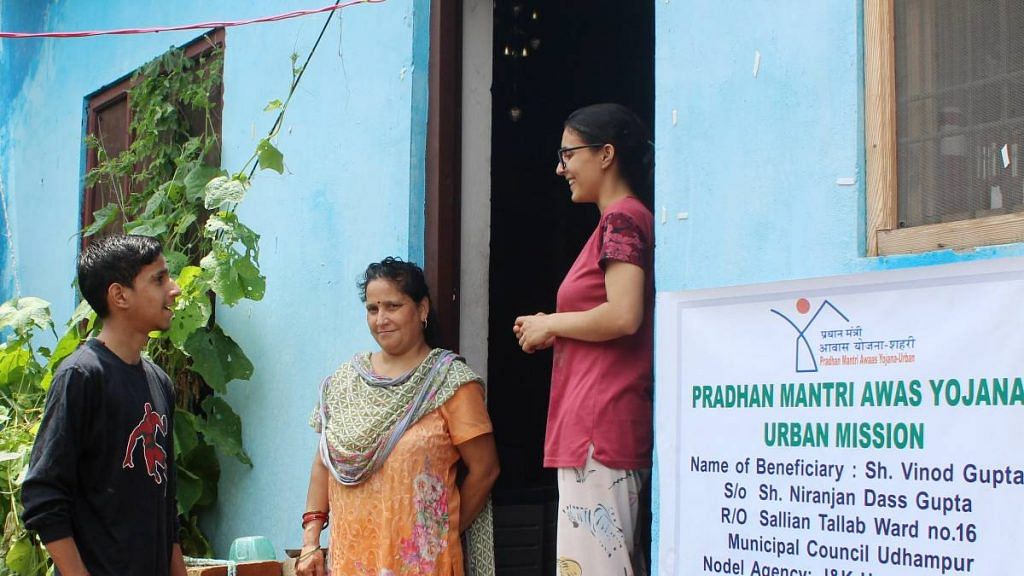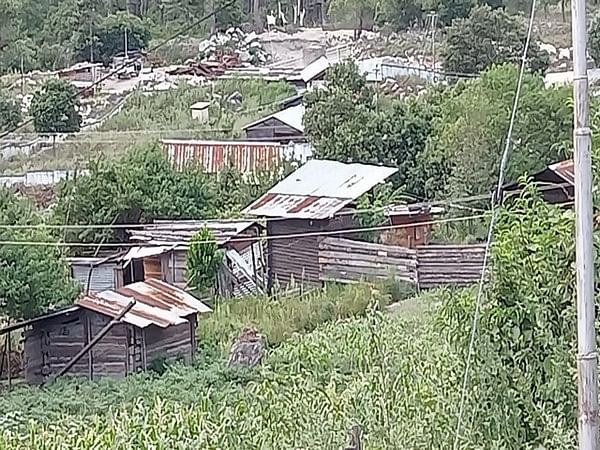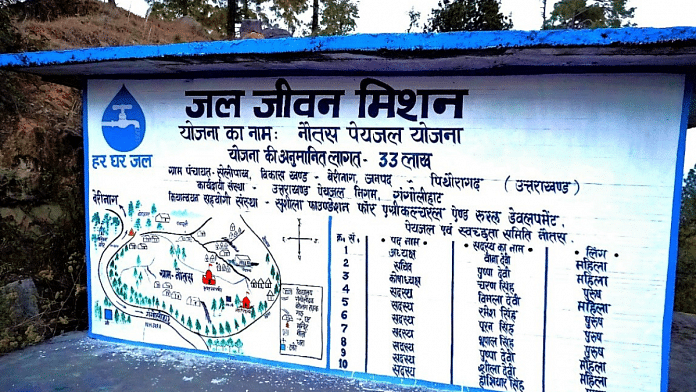New Delhi: The Modi government has put its money where its mouth is, more or less, in at least three key infrastructure- and defence-related announcements made in the last Budget, paving the way for the completion of some and more progress in others in 2023-2024.
An analysis by ThePrint shows that the government is well on track for schemes to provide clean tap water, build affordable housing, and boost infrastructure along the border with China in the last year. Budget 2023 could see at least some through to the finish line.
In her Budget 2022 speech, Finance Minister Nirmala Sitharaman announced an allocation of Rs 60,000 crore to cover an additional 3.8 crore households under the Har Ghar, Nal Se Jal programme for providing tap water.
For the PM Awas Yojana for affordable housing, she said that Rs 48,000 crore was allocated to complete 80 lakh houses for identified eligible beneficiaries by the end of the fiscal year.
She also announced the new Vibrant Villages programme to develop sparsely populated settlements along northern border that “often get left out from the development gains”.
While Sitharaman did not specify a budgetary allocation, she noted that “additional funding” would be provided to construct village infrastructure, connectivity, and other amenities. “Existing schemes will be converged. We will define their outcomes and monitor them on a constant basis,” she added.
Here is a look at the headway that these three schemes have made in the nearly 12 months since the Finance Minister made her Budget 2022 announcements.
Also Read: Budget 2023 must focus on agricultural productivity, not production. Go beyond populism
Rural tap water scheme ‘on target for 2024’
The government’s flagship Har Ghar, Nal Se Jal mission to provide potable drinking water through individual tap connections in all rural households is in its final leg. Launched in 2019, the mission period ends in August 2024, after the Modi government’s current term ends.
The Jal Shakti Ministry’s Department of Drinking Water and Sanitation (DDWS) has utilised close to 60 per cent of the Rs 60,000 crore allocated for the scheme in the 2022-23 budget.
As of 19 January this year, 56.62 per cent of the 19.22 crore rural households in India have been provided a functional tap water connection, according to data from the Ministry of Jal Shakti. The ministry now has the uphill task of covering the remaining 43.38 per cent rural households by August 2024.
A senior official of the Jal Shakti Ministry told ThePrint that they are hopeful of meeting the 2024 deadline. “There was a slowdown in 2020-21 because of the Covid pandemic but states are catching up now. Funds are not an issue for the scheme,” the official said.
So far, seven states and UTs — Goa, Haryana, Telangana, Gujarat, Puducherry, Dadra & Nagar Haveli, and Daman & Diu, and Andaman & Nicobar Islands — have achieved the target of achieving 100 per cent tap water connection.
‘Housing for all’, but not quite yet
A flagship scheme to provide pucca low-cost houses for eligible families across India, the Pradhan Mantri Awas Yojana (PMAY) has two distinct urban and rural legs, which were launched in 2015 and 2016 respectively.
While the PMAY (Urban) is being implemented by the Ministry of Housing and Urban Affairs, the PMAY (Gramin) is being carried out by the Ministry of Rural Development.

Of the total Rs 48,000 crore announced for the scheme in the last Budget, Rs 28,000 were for PMAY (U) and Rs 20,000 crore for PMAY (G). Both legs of the programme were extended as the sanctioned houses could not be completed by the targeted deadlines.
PMAY (U) was to be completed by August 2022, but its deadline was extended last year to 31 December 2024.
The Ministry of Housing and Urban Affairs is providing financial assistance for the completion of the 122.69 lakh houses that were sanctioned till March 31, 2022. Of these, 65.50 lakh houses were completed as of 12 December last year, Kaushal Kishore, Minister of State for Housing and Urban Affairs, informed the Lok Sabha last month.
In the 2022-23 budget, PMAY (U) was allocated Rs 28,000 crore, but to achieve targets, the ministry is seeking more funds.
For 2022-23 and 2023-24, the ministry had said that it would need “approximately Rs 82,000 crore more” in an action taken report submitted to the standing committee on housing and urban affairs.
In a report tabled in Parliament last March, the standing committee noted that the Ministry of Finance “has currently agreed to allocate only Rs 28,000 crore and assured that rest of the funds will be allocated gradually in the subsequent years.”
As for PMAY (G), the deadline to complete 2.92 crore houses was March 2022. But the timeline has now been extended till March 2024. A total of 2.10 crore houses were completed by the end of December 2022.
A need to bolster border villages
When the Finance Minister announced the Vibrant Villages programme for northern border areas in the last Budget, it came in the backdrop of the continuing border standoff in Eastern Ladakh as well as China’s setting up of ‘model villages’ close to the Line of Actual Control (LAC).
In her speech, Sitharaman outlined that the programme would “include construction of village infrastructure, housing, tourist centres, road connectivity, provisioning of decentralised renewable energy, direct to home access for Doordarshan and educational channels, and support for livelihood generation.”
While the exact allocation for this scheme was not determined, the border management funds allocated to the Ministry of Home Affairs saw more than a 42 per cent increase from Rs 1921.39 crore in 2021 to to Rs 2,517.02 crore.
Sources in the defence establishment said that efforts are on at the unit level to ensure that border villages get basic infrastructure and services.
“As the Army, we try to ensure that we are always there when the villages need us. From setting up medical camps for both humans and animals, to providing them with roads for easy movement and to focusing on their education, the Army tries to accommodate everything,” a source said.

The defence ministry has been working with other ministries to ensure speeding up of border infrastructure because it not only benefits the local population but also helps the armed forces with ease of movement.
Last year, the Ministry of Defence approved the setting up of wayside amenities at 75 locations across 12 states and Union Territories on different sections of roads with the Border Roads Organisation (BRO).
Known as BRO cafes, these amenities have been built for attracting tourists to border villages, including in remote reaches of Ladakh and Arunachal Pradesh, and for generating local employment.
Army sources told ThePrint that it was in the country’s security interests to reduce migration from border villages, which is an issue that was taken up at multiple levels with the government.
The sources added that the civilian population is the first line of defence when it comes to border villages because the local people are first to see and hear any intrusion attempt by the Chinese. Further, they said, civilian settlements are also important in establishing claims over the territory — which is precisely why China is also building villages along the LAC.
These Chinese border defence villages, called the Xiaokang (moderately prosperous), have good road infrastructure, electricity, and internet facilities. They can easily accommodate about 1,000 people and are meant for dual purposes — military and civil. In Arunachal Pradesh alone, there are about 600 villages within the 10 km radius of the 1,046-km LAC that the state shares with China-controlled Tibet.
On the Indian side, the sources in the defence establishment said, the people have moved out from villages close to the LAC to the cities due to tough terrain and a lack of infrastructure, an issue which was flagged way back in 2013.
Villages on the Indian side lack even basic infrastructure like medical and clean drinking water supply, besides other necessities like mobile phone connectivity. Mobile phones instead pick up Chinese networks in border areas.
In 2021, villagers from Chushul, along the LAC in eastern Ladakh, petitioned to Defence Minister Rajnath Singh seeking infrastructure development, 4G connectivity, and permission for nomads to graze their livestock on traditional pastureland from Hot Springs to Pangong Tso.
The villagers had sought a 4G tower for each of the nine villages in Chushul, besides fibre optic cables.
Significantly, of the first things that the Chinese did after the tensions broke out in eastern Ladakh in 2020 was to lay down fibre optic cables on their side to ensure smooth communication links.
The villagers had also sought better medical and education facilities, and a reliable supply of electricity to ensure that border residents do not migrate to Leh.
(Edited by Asavari Singh)
Also Read: Budget 2023 priorities should include thrust on public capex, rural job creation






